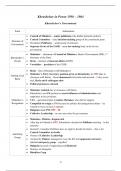Summary
Summary OCR A-Level History, Russia and Its Rulers - Depth Study - Khrushchev in Power
- Course
- Institution
OCR A-Level History, Russia and Its Rulers - Depth Study - Khrushchev in Power, including Khrushchev's government, de-stalinisation, repression and enforcement, economic and social policies, foreign policy, Khrushchev's fall
[Show more]



